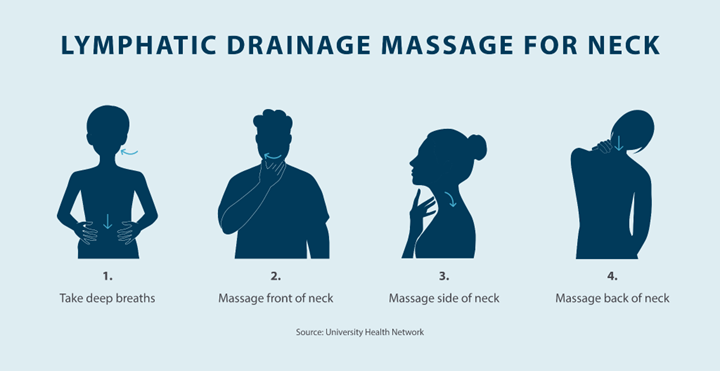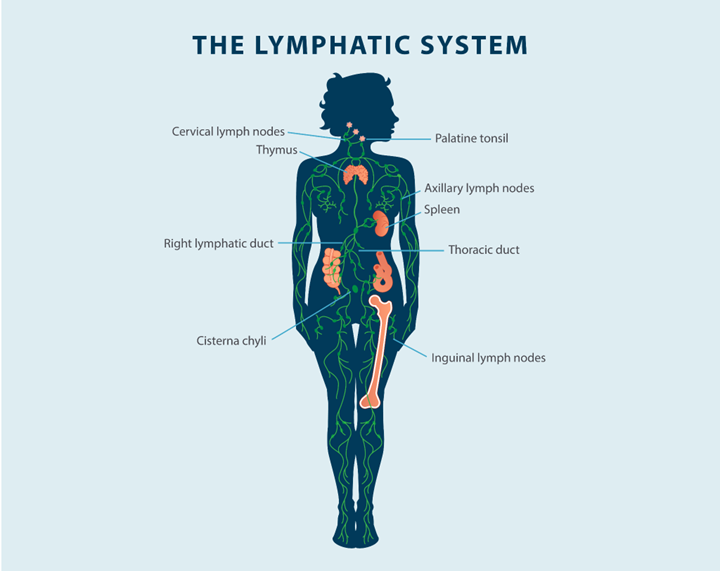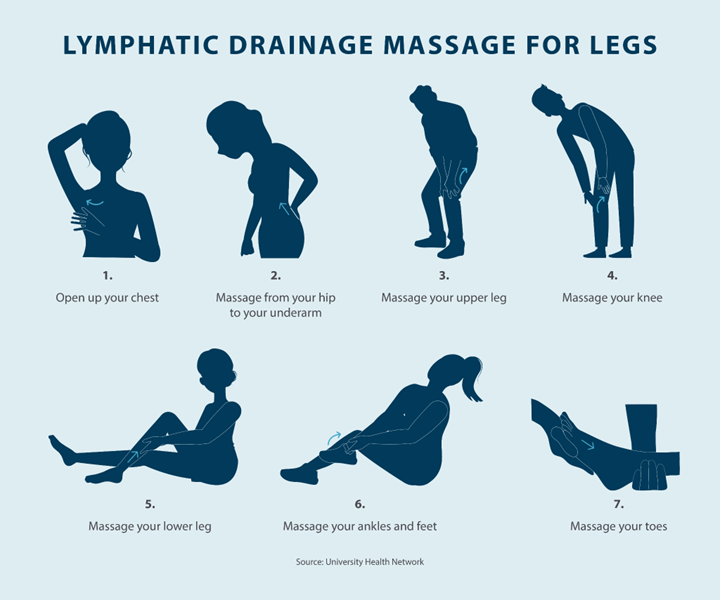Inflammation vs Swelling
Review our guide on the differences between inflammation vs. swelling, so you can understand how they impact your body differently.
Read More

If you’re living with lymphedema, lipedema, or a similar condition, you can take steps to get relief from pain and the other symptoms at home. Lymphatic massage can be used to relieve the swelling in your arms, legs, or other affected areas. The technique works by helping to promote lymphatic drainage. If you’re looking to learn how to do a lymphatic massage, we’ll cover everything you need to know in this article.
What Is the Lymphatic System?
What Is a Lymphatic Drainage Massage?
How to Do a Lymphatic Massage at Home
How Can Self-Massage Help With Lymphedema?
Wrapping Up: How to Do a Lymphatic Massage
The lymphatic system is a network in your body that consists of vessels, nodes, and organs, all of which help fight foreign invaders and move lymph fluid back into your circulatory system from your body’s tissues. The fluid that flows through your lymphatic system is part of your immune system and consists of fat, water, protein, cellular debris, and white blood cells. The lymph nodes and vessels help filter lymph fluids to remove cellular waste from the body.

When there’s a disruption in your lymphatic system, it can interrupt the flow of fluid. Instead of that fluid reentering your bloodstream, it will remain in the tissues, which may eventually lead to swelling. This swelling as a result of a buildup of fluid is known as lymphedema, and it can lead to pain, swelling, blisters, skin ulcers, and infections if left untreated. If you think you may have lymphedema, you should talk to your doctor about lymphedema treatment options.
A lymphatic drainage massage is a technique used to relieve the swelling in your arms and legs as a result of lymphedema. This massage technique works by helping to promote lymphatic drainage. By gently massaging the tissues, you can relieve some of the swelling and pain that can come with lymphedema. However, it’s important to know how to do a lymphatic drainage massage to get the full benefit.
As long as you use the proper techniques, you can perform a lymphatic massage at home. Aside from deep breathing, each step in the massage should be repeated 10 to 15 times. Here’s a complete breakdown of how to do a lymphatic drainage massage:
1. Practice deep breathing
Before you begin your lymphatic massage, take a moment to practice deep breathing. Deep breathing can help stimulate your lymphatic system to encourage drainage, which is what you’re trying to accomplish with this massage. Breathe in slowly through your nose and out slowly through your mouth. Focus on your breaths and make sure they’re slow, deep, and steady.

2. Massage the front of your neck
Take your index finger and your middle finger, and place them on one side of your neck just above the collarbone. Massage down toward your collarbone and inward toward the center of your neck in a “J” shape. If you’re going to massage both sides of your neck at the same time, you should cross your arms.
3. Massage the sides of your neck
Next, place one or both hands on the sides of your neck below your ears. Gently massage toward the back of your head, then in a downward motion. Be careful not to apply too much pressure, as you don’t want to hurt your neck massaging it.
4. Massage the back of your neck
This is the last of the head and neck lymphatic massage. Simply put your hands on the back of your neck, right below the hairline. Stretch your skin inward, then down toward your back, and release it. Remember to be gentle, as this is a tender area of your neck.
5. Open up your chest
For this step, raise the affected arm slightly and place your opposite hand against that underarm. To perform this lymphatic massage, pull up and inward 10 to 15 times, but be careful, as this can be a very sensitive area. If you’re experiencing pain during this step, apply less pressure when massaging your underarm.

6. Massage from your hip to your underarm
Now, lift the affected arm straight up, exposing the side of your body that’s affected by lymphedema. Take the opposite hand and place it flat on your exposed hip. Next, massage from your hip up the side of your body to your underarm using short strokes. Don’t stretch your skin any further than it naturally goes.
7. Massage your upper leg
Once you’ve taken care of the upper body massages, you’ll want to get into a different position for your leg massage. Try placing your foot on the other knee, resting your foot on a stool, or putting your foot on a stable object that’s a little higher to find a comfortable position that doesn’t cause back strain.
For the upper leg massage, place one hand on the inside of your leg and one hand on the back of your leg. Gently massage from the inside of your leg toward your hip and the side of your body, moving further down your leg and repeating these steps until you’ve massaged your way to your knee. Then, gently massage from your knee up the side of your body and toward your underarm.
8. Massage your knee
Next, it’s time to massage your knee. You can do this by placing both of your hands behind your knee and gently massaging in a “J” shape. This is another area that can be sensitive if you press too hard, so make sure you’re gently massaging the back of your knee 10 to 15 times.
9. Massage your lower leg
For your lower leg, place one hand on your shin and the other hand below your knee. Gently massage upward with both hands to encourage lymphatic fluid to flow upward, occasionally moving down a bit lower on the leg. Once you’ve reached the ankle, you can move on to the next step.
10. Massage your ankles and feet
Massaging your ankles and feet is a simple process once you’ve massaged your lower legs. Simply repeat the same motion you used to massage your lower legs on your ankles and feet, and remember to always stroke upward toward your lower legs to promote the flow of lymph fluid.
11. Massage your toes
If your toes are swollen, you can gently massage them to release some of the built-up lymph fluid. Use your index finger and thumb to gently massage from the end of your toes to your feet, being extra careful not to massage too hard.
There are a handful of lymphedema treatment and management options, so where does a self-massage fit into your treatment plan? While a lymphatic drainage massage isn’t a substitute for other treatment methods, it can be an effective way to relieve swelling and pain from lymphedema without visiting a doctor. By moving lymph fluid away from the areas where there’s increased swelling, you can relieve some of that swelling as well as the symptoms of lymphedema.
Before you learn how to do a lymphatic massage, you should ask your doctor or lymphedema therapist if it’s right for you. While lymphatic drainage massages can produce great results for some people, they may not work that well for everyone. You may also want to avoid these massages if you have skin ulcers, edema blisters, or other skin problems as a result of lymphedema. Additionally, you can visit a lymphedema specialist who can perform a lymphatic massage for you, as well as teach you proper techniques to try at home.
Lymphatic massages are a simple way to encourage lymphatic drainage and reduce the swelling that results from lymphedema. Once you’ve learned how to do a lymphatic massage, you can perform your own massages at home to relieve pain and swelling. However, these massages shouldn’t replace other lymphedema treatments that your doctor may recommend.
If you need help reducing swelling and pain caused by lymphedema, Tactile Medical can help. At Tactile Medical, we have pneumatic compression devices that offer lower body lymphedema treatment, upper body lymphedema treatment, and head and neck lymphedema treatment. Our Flexitouch Plus system helps stimulate your lymphatic system to promote the flow and drainage of fluid, relieving swelling and pain for people with lymphedema. To find out more about how Tactile Medical can help, check out the Flexitouch Plus system today.
Review our guide on the differences between inflammation vs. swelling, so you can understand how they impact your body differently.
Read More
Review our guide on chronic venous insufficiency (CVI) to better understand the symptoms, causes, and treatment options to get the care you need.
Read More
The lymphatic system helps our body fight diseases and infections. Find out more about the lymphatic system and its functions in this guide.
Read More
Lymphatic circulation is a key part of the immune system. Learn more about the role of the lymphatic system in the body.
Read More
Call us at 1.800.575.1900